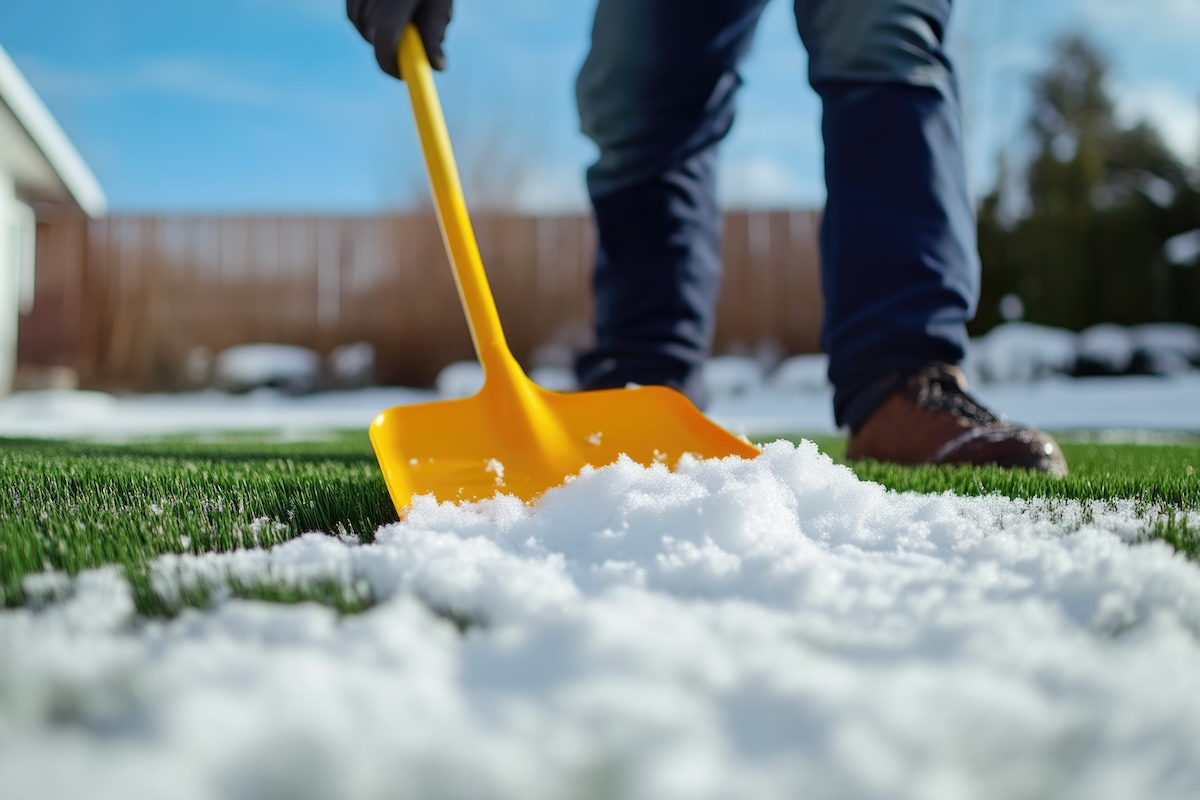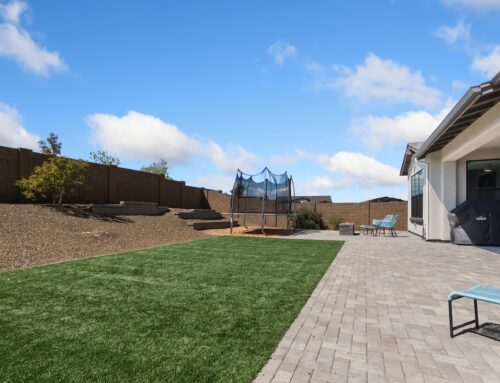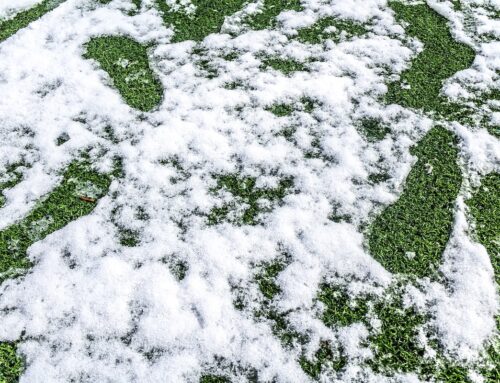Last Updated on December 16, 2024 by ReTurf
Winter has a way of changing things. Everything slows down, the snow makes things feel quieter, and your everyday outdoor space starts to look a little different. If you’ve got artificial turf, you might be looking out at it and thinking, “Well, how’s this stuff gonna hold up now?”
That’s a fair question. Fortunately, the fact is that artificial turf handles winter a whole lot better than you might expect. Modern turf is engineered from durable, weather-resistant materials that don’t crack, fade, or warp when the mercury dips. (And of course, it doesn’t brown or die off like natural grass, and you won’t be dealing with those soggy, muddy messes when the snow starts to melt.)

But still, winter has its quirks, and it’s worth knowing what to expect. Snow, ice, and freeze-thaw cycling do bring up plenty of practical questions—for example:
- What happens if snow piles up?
- Will ice harm the fibers or the backing?
- Is it safe to use a snowblower or shovel to clear your turf?
There’s a lot to unpack when it comes to caring for artificial grass during the colder months, and while it’s generally low-maintenance, a little know-how goes a long way in keeping your turf looking great. So if you’ve ever caught yourself wondering, “Does snow mess up fake grass?” or “Can I use a snowblower on this stuff?”—well, you’re in the right place. Let’s get into it and take the mystery out of synthetic turf care this winter.
General Winter Considerations
Q: Can you leave artificial grass out in the winter?
A: Absolutely, you can leave artificial grass out in the winter. It’s designed to handle all kinds of weather, including snow, frost, and freezing temperatures. Unlike natural grass, it won’t die or turn brown, so no winterizing is needed to keep it looking good.
Even during heavy snowfall, it stays resilient and bounces back once the snow melts. The backing is made from durable materials that resist the expansion and contraction caused by temperature changes, so you don’t have to worry about it warping or becoming unstable.

As long as the turf was installed with proper drainage, you won’t have to worry about water pooling or freezing in ways that could cause damage. Just let the snow come and go—your turf will handle it like a champ.
Q: How does artificial turf hold up in winter?
A: Artificial turf holds up just fine in winter. It’s made to withstand snow, frost, and freezing temperatures without breaking down. You might notice it feels a little stiffer in the cold, but that’s normal and doesn’t harm its durability.
The fibers are designed to spring back after snow melts, so you don’t have to worry about it flattening. Plus, most professionally-installed artificial turf systems will have excellent drainage, meaning that melted snow won’t pool or create muddy spots like natural grass.
Q: Can artificial grass freeze?
A: Yes, artificial grass can freeze when temperatures drop, but that doesn’t mean it’s damaged. The surface might feel hard, and the fibers could stiffen temporarily, but it’ll return to normal once the weather warms up.
Just avoid heavy activity on the turf when it’s frozen to keep everything looking its best—frozen blades can be less flexible and more prone to temporary flattening.
Q: Does frost damage artificial grass?
A: Nope, frost doesn’t damage artificial grass. The materials are engineered to endure winter conditions without cracking, warping, or wearing out from frost exposure.
Unlike natural grass, it doesn’t get brittle or suffer frost burn, so it’ll stay green no matter how many frosty mornings you get. Any frost on the blades will melt off naturally and won’t affect performance or appearance in the long run.
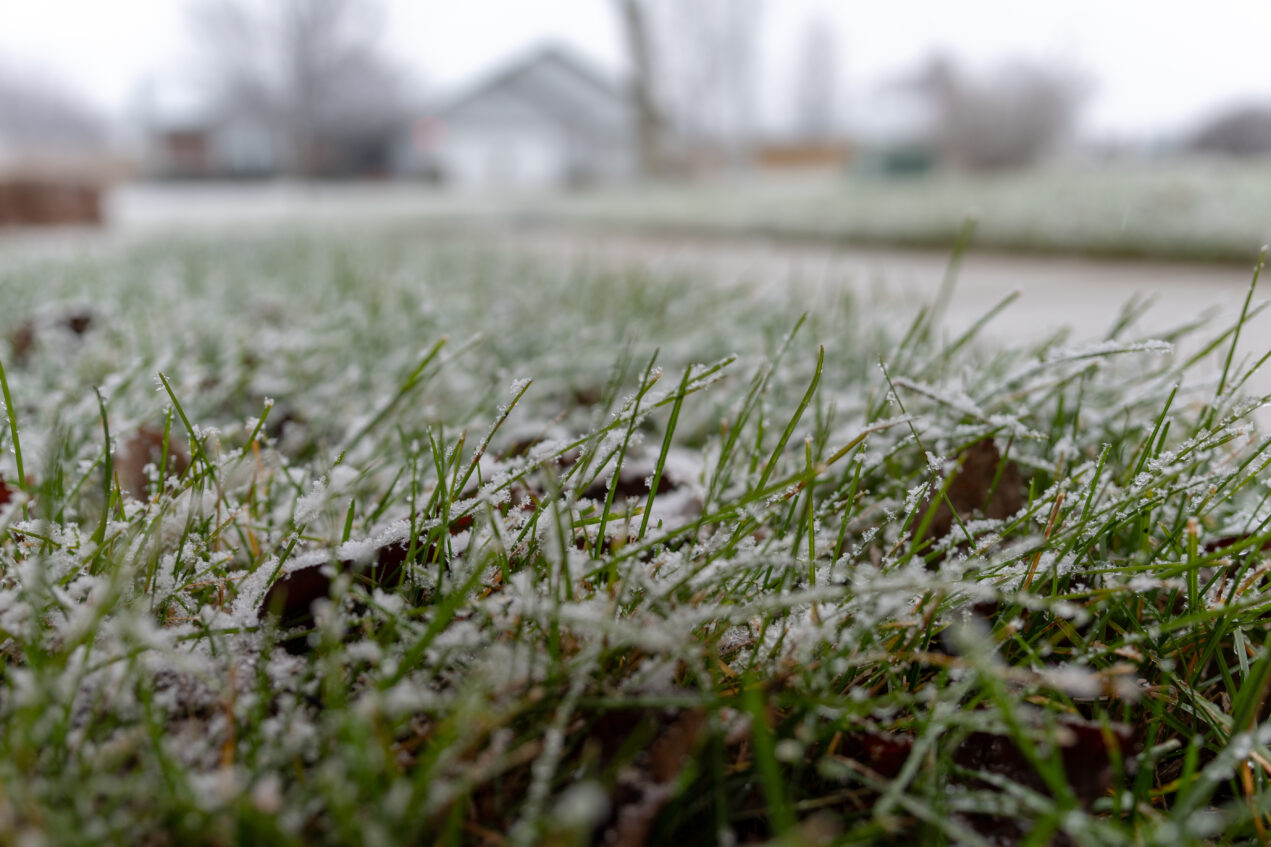
Q: Is artificial grass affected by frost heave?
A: Artificial grass itself isn’t affected by frost heave, but the ground underneath might shift if it wasn’t properly prepared during installation. That’s why a good drainage system and a stable base are especially important when installing turf in colder climates. A pro installation typically includes a compacted aggregate base that prevents ground movement during freezing and thawing cycles. If the base is done right, frost heave isn’t something you’ll need to worry about.
Q: Can artificial turf crack in freezing weather?
A: It’s highly unlikely unless it’s an old, past its prime, or poor-quality turf. Even years-old, reused stadium-grade artificial turf is built to handle freezing weather without cracking. These products are designed for durability, making them resilient even under extreme conditions.
Higher-grade, modern artificial turf is flexible enough to handle freezing temperatures without cracking or breaking. If you’ve invested in a reputable turf product, freezing weather won’t be a concern.
Q: Does artificial grass discolor in freezing weather?
A: Higher-quality artificial grass will keep its green color no matter the season. Freezing temperatures and snow won’t cause any fading or discoloration. The UV protection built into the turf helps keep it from bleaching or dulling, even with the extra reflection from snow. So, whether it’s sunny, snowy, or frosty, your turf will keep its lush appearance year-round.
Installation & Preparation for Winter
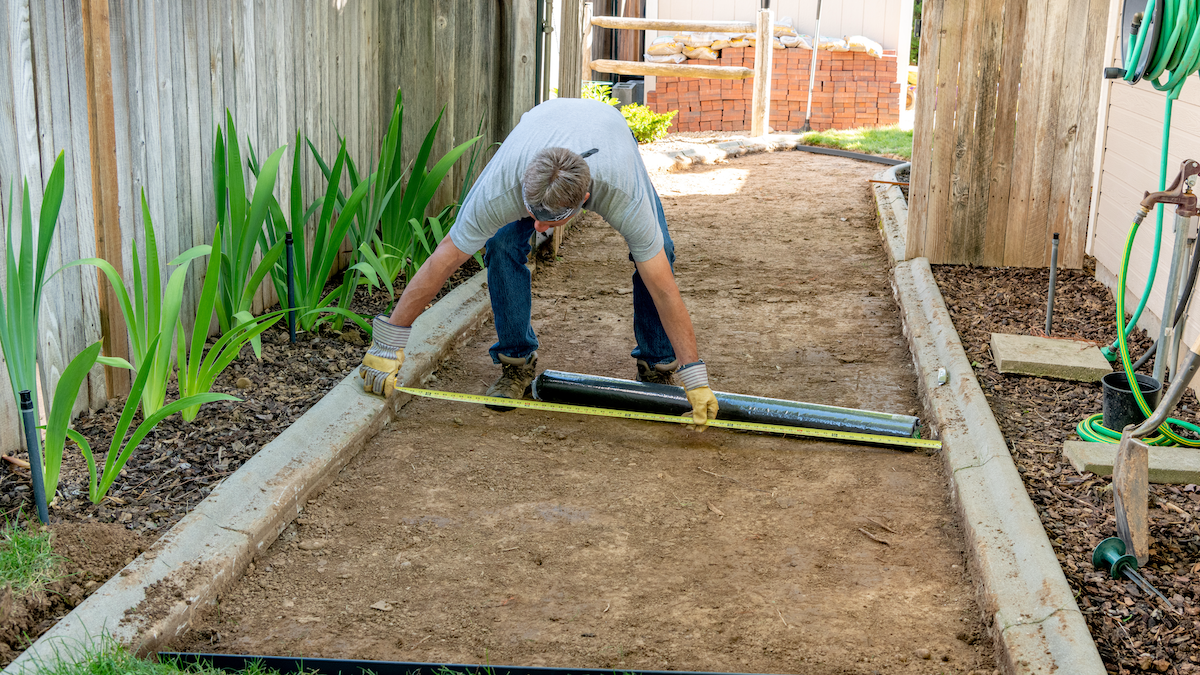
Q: Can you lay artificial turf in the winter?
A: You sure can, though you might run into some hiccups if the ground is frozen or snow-covered. If you’re in a hurry, make sure the installation team knows how to handle cold-weather conditions properly.
You sure can, but winter conditions might slow things down or require adjustments. If you’re in a snowy or cold region, snow and frozen ground can make site prep harder. The base material might not settle as evenly if it’s too wet or icy, and adhesives can take longer to cure in colder temperatures.
If you’re in a region where winters are mild, laying turf during the cooler months can actually be pleasant, as there’s less heat to contend with during the install. Just keep in mind that while the turf itself can be laid in any season, proper preparation is what makes or breaks the durability of the installation.
Q: How do you protect artificial turf in the winter?
A: Protecting your turf is as simple as letting it do its job. Artificial turf is designed to handle cold, snow, and even frost without any special treatment.
If you’re in a place that gets heavy snowfall, you can brush off large piles of snow to prevent it from compacting too much—but even that’s more for convenience than necessity.
If ice forms on the turf, it won’t harm the material, though you’ll want to avoid using sharp tools or harsh chemicals to remove it. A plastic shovel or broom works fine for snow removal if needed. For the most part, winter won’t do anything that spring sunshine and normal maintenance won’t fix.
Q: How do you winterize artificial turf?
A: Good news—you don’t need to winterize artificial turf! It’s built to hold up to all sorts of winter weather, from rain and frost to snow and ice. The main thing to check before winter sets in is your drainage system. Make sure the base drains properly so melting snow doesn’t cause pooling, which could freeze and create slippery areas. If your area gets lots of snow, you might want to brush off the turf after heavy storms, but otherwise, there’s no need to cover it, add chemicals, or take any other special measures. The turf will handle winter just fine on its own.
Q: Should you cover artificial grass in the winter?
A: Nope, there’s no need to cover artificial grass in winter. The materials are engineered to stand up to snow, rain, and frost without any protective coverings.
In fact, covering it could trap moisture, which might freeze and create slippery conditions. Plus, covers can be tricky to keep secure during windy weather. If you’re in an area with heavy snow, it’s more practical to brush off the turf occasionally than to cover it. Just let the turf do what it’s designed to do, and it’ll bounce back once winter is over.
Snow & Ice Management

Q: Does artificial turf hold up in snow?
A: You bet it does. Snow won’t harm the turf or its backing. When the snow melts, it’ll drain away just like rainwater.
The snow might weigh the fibers down temporarily, but they’ll spring back up once it melts. Plus, since artificial turf doesn’t absorb water, you won’t deal with the soggy mess you’d get with natural grass during thawing periods. It drains quickly, so you won’t see puddles sticking around.
Q: Does snow affect artificial grass?
A: Snow doesn’t harm artificial grass, though it might make the surface slippery. Once it melts, your turf will look and feel just as it did before the snowfall.
Q: Can artificial turf handle heavy snowfall?
A: It sure can. The weight of snow won’t damage the turf. Once the snow melts, the turf will bounce back to its normal state.
Even with significant snowfall, the turf will hold up just fine as long as it was installed on a properly compacted base with good drainage. If the snow compacts into ice over time, the surface might feel firmer underfoot temporarily, but this won’t harm the turf.
Q: Does snow damage artificial turf?
A: Not at all. Snow might compact the grass temporarily, but it won’t cause lasting damage. Even if snow compacts heavily over time, it won’t hurt the turf’s structure or color. Just let nature take its course, and the turf will spring back to normal as the weather warms.
Snow doesn’t impact the grass beyond making it temporarily slippery or causing the fibers to flatten under its weight. If snow lingers for long periods, brushing the surface gently after it melts can help fluff the fibers back into place.

Q: Does snow stick on turf?
A: Snow can stick to artificial turf, just like it does on natural grass or sidewalks. It’s easy to remove if needed, though.
Snow sticks to artificial turf just as it would on any outdoor surface, but it generally doesn’t cling in a way that’s hard to remove. Brushing or gently sweeping the turf will usually take care of any lingering snow or ice patches.
Q: Does snow melt faster on artificial turf?
A: Sometimes, yes. The turf’s surface can absorb a bit of heat from the sun, which helps snow melt faster than it might on natural grass. This depends on the amount of sunlight and ambient temperature.
Artificial turf doesn’t retain the same cold moisture as natural grass, so it often absorbs heat more efficiently, leading to faster snowmelt in sunny conditions. However, in shaded areas or during extremely cold weather, the melting rate may be similar to other surfaces.
Q: What happens if ice forms on artificial grass?
A: If ice forms, it won’t damage the turf, but it might make it slippery. Once temperatures rise, the ice will melt away without leaving any lasting effects.
While ice doesn’t damage artificial grass, it can make the surface less safe to walk on. If you need to remove the ice, stick to safe methods like using a turf-friendly deicer or letting the sun do its work. Avoid picking at the ice with sharp tools, which could harm the fibers or backing.
Q: Does artificial grass become slippery in the winter?
A: It can get slippery when there’s ice or frost on it, just like any other surface. Be cautious if you’re walking on it during icy conditions.
Slippery conditions are more noticeable with frost or ice than with snow. If this is a concern, take the same precautions you’d use on any slippery outdoor surface, like spreading a safe deicer or limiting foot traffic until conditions improve.
Q: Will compacted snow damage artificial grass fibers?
A: No, compacted snow won’t harm the fibers. Once the snow melts, the turf will fluff back up on its own.
Even if snow is compacted by foot traffic or shoveling, the fibers are designed to be resilient. A quick brushing after the snow melts can help the turf regain its shape, especially in high-traffic areas.
Q: Can artificial turf backing be damaged by ice?
A: Only if the ice is combined with sharp tools or improper removal methods. Avoid digging into the turf with metal tools, and you won’t have to worry.
The backing of high-quality artificial turf products will be durable and won’t be harmed by ice itself, but repeated freezing and thawing can occasionally cause minor issues if the turf wasn’t installed on a properly compacted and draining base. This is rare, though, and typically only a problem with improper installation. Stick to soft tools and safe ice-removal methods to avoid unnecessary stress on the material.
Snow & Ice Removal/De-Icing

Q: How to remove snow from artificial turf?
A: A broom or plastic shovel works best. Avoid metal tools, as they can damage the fibers. For light snow, a leaf blower can also do the trick.
Q: Is shoveling snow on artificial turf safe?
A: Yes, as long as you use a plastic shovel. Metal shovels can scratch or tear the turf, so steer clear of those.
Q: Are snow shovels or brooms better for artificial turf?
A: Brooms are gentler and better for light snow. A stiff-bristled broom works great for brushing away a dusting of snow or even a couple of inches if you don’t mind putting in a bit of elbow grease.
Now, if you’re dealing with heavier snow, a plastic snow shovel can come in handy. Make sure it’s plastic, though—metal shovels can scratch or tear the fibers or even ding the backing if you get too aggressive. When you’re shoveling, keep the blade at a slight angle to avoid digging into the turf.
Q: Can you use a snowblower on artificial turf?
A: Yes, but only if you’re careful. Make sure the blades don’t touch the turf directly, and avoid using one with metal components. Stick with a single-stage snowblower with rubber or plastic blades—those won’t scrape or snag on the turf the way metal blades might.
Keep the blower height adjusted so it just skims the surface, clearing the snow without digging into the grass.
A snowblower is a great tool for big areas or heavy snowfalls, but like anything else, a little care goes a long way. Always give your turf a quick once-over afterward to make sure everything looks good.
Q: How do you remove ice from artificial grass safely?
A: Try breaking up the ice with a broom or using a safe ice melt product. Avoid pouring hot water directly onto the ice, as it could refreeze and cause more issues.
Q: Can you pour boiling water on artificial grass?
A: Nope, I wouldn’t recommend it. It might seem like a quick way to melt ice, but boiling water can actually cause more problems than it solves.
For starters, in freezing weather, that water’s likely to refreeze pretty fast, which can leave you with an even slicker, icier mess than you had to begin with. Plus, all that heat isn’t exactly friendly to the turf’s backing or fibers—it could warp or weaken the materials over time, especially if you make a habit of it. If you want to deal with ice, a turf-safe ice melt or just letting the sun do its job is a much better way to go.
Q: What’s the best way to dry artificial turf after snow or ice?
A: Just let nature do its job. If you’re in a hurry, brushing the turf can help speed things along. Good drainage will take care of the rest.
Q: Can you use ice melt on artificial turf?
A: Yes, but choose a turf-safe product. Look for ice melt that’s labeled safe for use on synthetic surfaces.
Q: Is salt safe to use on artificial turf for deicing?
A: Regular salt isn’t ideal, as it can build up and damage the backing over time. Use a pet-safe or turf-safe ice melt instead.
Q: What is the safest ice melt for grass?
A: Look for calcium chloride-based products labeled as safe for artificial turf. These are less likely to cause damage.
Q: How do you clean artificial grass in the winter?
A: A quick brush with a broom will clear away debris or light snow. If it’s icy, a turf-safe ice melt can help. Regular maintenance isn’t much different from other seasons.
Let It Snow—Your Turf’s Got This
Winter might bring its fair share of snow and ice, but artificial turf is more than ready to handle whatever the season throws its way. Sure, it’s a bit different from natural grass, but in a lot of ways, it’s easier to manage. You don’t have to fuss over it with winterizing, it won’t turn into a muddy mess come spring, and it’ll stay green no matter how cold it gets.
That said, every yard and every winter is a little different. If you’re in a spot that sees heavy snow or long stretches of ice, a little common-sense care can go a long way. Stick to gentle tools, avoid sharp objects, and let your turf’s drainage do its thing.
Winter might not be peak yard season—well, unless maybe you’re in Florida or somewhere else that’s still rocking 70 degree highs in December—but it’s a time to appreciate a yard that’s low-maintenance. Whether you’re looking out at a snow-dusted lawn or clearing off a path for the dog, it’s good to know you won’t be dealing with dead patches, mud puddles, or frost-damaged grass when the cold finally lets up.
Stay warm, stay safe, and when the snow finally melts, you’ll have a green, clean yard waiting for you.

